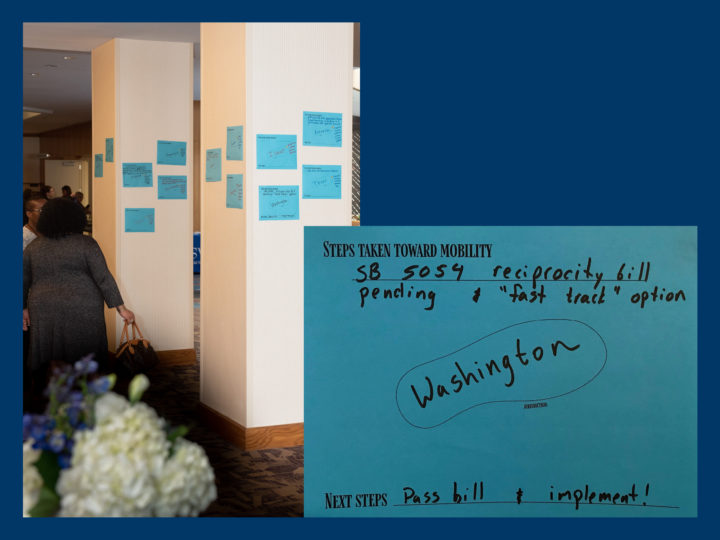Mobility steps made easier

The second goal of the 2019–2021 Strategic Framework, “Facilitate mobility by licensure through endorsement,” carries to the next step the work done by ASWB members over the past several years: To effect change in social work regulation to decrease burdens on social workers who want to add a license in a new jurisdiction.
 When ASWB members voted to change the Model Social Work Practice Act in 2018 by adopting licensure by endorsement language, you indicated that the best, most efficient, way to enhance practice mobility is to allow, in the words of the strategic framework, “a licensed or registered social worker in good standing in one jurisdiction to practice in other jurisdictions without having to undergo significant additional training, experience, examinations, or assessments.”
When ASWB members voted to change the Model Social Work Practice Act in 2018 by adopting licensure by endorsement language, you indicated that the best, most efficient, way to enhance practice mobility is to allow, in the words of the strategic framework, “a licensed or registered social worker in good standing in one jurisdiction to practice in other jurisdictions without having to undergo significant additional training, experience, examinations, or assessments.”
The core action of the second goal revolves around the word “facilitate,” which means to “make easier.” ASWB aspires to make embracing licensure by endorsement easier for members. Now that we’ve entered the implementation phase of Mobility, it’s time to remind members that ASWB has multiple resources that can help you and solutions that you can share.
This year the association news will feature articles related to the 2019–2021 Strategic Framework. Watch for the icon appearing next to the title in each issue.
The model law
The ASWB Model Social Work Practice Act offers regulators and lawmakers a best practices example of what laws governing the practice of social work should look like. When a jurisdiction wants to improve its own laws, rules, and regulations, members will most likely find language in the model law. Since the language comes from ASWB members, regulators can be confident that public protection remains at the forefront.
Because the model law promotes consistency in regulation, its use helps regulators build trust that social workers licensed elsewhere have substantially similar qualifications when applying for an equivalent license in their jurisdiction. And the model law’s consistent language around licensure by endorsement helps jurisdictions communicate accurately with one another and with their stakeholders—licensees, legislators, and consumers alike.
The mobility website
MovingSocialWork.org serves as an information hub for anyone who needs to know more about practice mobility challenges and solutions. Regular updates offer approachable content that aims to answer questions about adding licenses, provide expert advice, compile resources, and relate stories of progress toward mobility. This material is meant to be shared!
Some highlights from recent posts:
- In its research into mobility readiness, ASWB has noted that among the “three E’s and a fee,” the supervised experience requirement—along with specific rules around documenting hours—often creates a barrier for licensees seeking to add a new license. Cara Sanner, ASWB regulatory services coordinator, brings her expertise to a common licensee question in Will my supervision hours transfer?
- The Zen of licensure endorsement clarifies how the adjustment to wording in the model law adopted in 2018 leads to public protection.
- A mobility success story culminated this month in Arizona, when the governor signed legislation providing licensure by endorsement to licensees in all occupations and professions, including licensed social workers. Under this new law, an individual moving into the state who has been licensed in good standing for at least a year in another state may be issued a license to practice in Arizona. Progress made: New Arizona legislation improves mobility tells Arizona’s story.
The education conference proceedings
As you begin your next steps toward implementing social work practice mobility in your jurisdiction, take out the tool kit you developed at ASWB’s 2018 Education Conference, Developing Tools for Social Work Mobility. If you want to add to or sharpen the tools you have, the conference proceedings are now compiled on the site and available to review with a new eye. See especially Step 4: Assess resources for a roundup of ASWB resources and solutions. As Jennifer Henkel, ASWB senior director of member services and strategic initiatives, said during the session, “Please use the resources that are available!”
Your association
Perhaps the greatest resource the association offers stems from ASWB’s role in connecting members with one another. Both major events that ASWB organizes, the Education Conference and the Annual Meeting of the Delegate Assembly, include daylong meetings—the Administrators Forum and the Board Member Exchange—at which member board staff and members can share common challenges and exchange ideas. Between meetings, ASWB’s Social Work Regulations Database can help members learn about how other jurisdictions license social workers already licensed in another jurisdiction.
And while your association exists primarily as a connection among member boards, ASWB also has experts in Culpeper, Virginia, eager to assist. Jurisdictions needing research can call on Cara Sanner, ASWB regulatory services coordinator, for answers. Other members of the Member Services and Strategic Initiatives department will provide consultation about available services—including Dave Ryczko and Jennifer Henkel. Members needing letters of support when weighing in on, for example, impending legislation can call on Henkel for this service. The Communications and Marketing department, under Jayne Wood, can offer customized advice and guidance on communications strategies that members can use to educate social workers and the public.
How members choose to respond to the challenge of mobility implementation as outlined in the strategic framework is a decision for each board. The association strives to support members’ efforts to educate and find solutions. The model law, the mobility website, the association itself, and other ASWB resources are here to ease the challenge.

